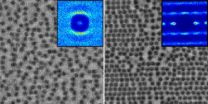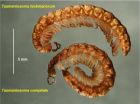(Press-News.org) PHILADELPHIA — A protein's function depends on both the chains of molecules it is made of and the way those chains are folded. And while figuring out the former is relatively easy, the latter represents a huge challenge with serious implications because many diseases are the result of misfolded proteins. Now, a team of chemists at the University of Pennsylvania has devised a way to watch proteins fold in "real-time," which could lead to a better understanding of protein folding and misfolding in general.
The research was conducted by Feng Gai, professor in the Department of Chemistry in the School of Arts and Sciences, along with graduate students Arnaldo Serrano, also of Chemistry, and Robert Culik of the Department of Biochemistry and Molecular Biophysics at Penn's Perelman School of Medicine. They collaborated with Michelle R. Bunagan of the College of New Jersey's Department of Chemistry.
Their research was published in the international edition of the journal Angewandte Chemie, where it was featured on the cover and bestowed VIP (very important paper) status.
"One of the reasons that figuring out what happens when proteins fold is difficult is that we don't have the equivalent of a high-speed camera that can capture the process, " Gai said. "If the process were slow, we could take multiple 'pictures' over time and see the mechanism at work. Unfortunately, no one has this capability; the folding occurs faster than the blink of an eye."
Gai's team uses infrared spectroscopy — a technique that measures how much light different parts of a molecule absorbs — to analyze proteins' structure and how this changes. In this case, the researchers looked at a model protein known as Trp-cage with an infrared laser setup.
In this experiment, Gai's team used two lasers to study structural changes as a function of time. The first laser acts as the starting gun; by heating the molecule, it causes its structure to change. The second laser acts as the camera, following the motions of the protein's constituent amino acids.
"The protein is made of different groups of atoms, and the different groups can be thought of as springs," Gai said. "Each spring has a different frequency with which it moves back and forth, which is based on the mass of the atom on either end. If the mass is bigger, the spring oscillates slower. Our 'camera' can detect the speed of that motion and we can relate it to the atoms it is made of and how that segment of the protein chain moves."
Even in a simple protein like Trp-cage, however, there are many identical bonds, and the researchers need to be able to distinguish one from another in order to see which of them are moving while the protein folds. One strategy they used to get around this problem was to employ the molecular equivalent of a tracking device.
"We use an amino acid with a carbon isotope marker," Culik said. "If it's incorporated into the protein correctly, we'll know where it is."
With a single carbon atom of the Trp-cage slightly heavier than the others, the research team can use its signature to infer the position of the other atoms as they fold. The researchers could then "tune" the frequency of their laser to match different parts of the protein, allowing them to isolate them in their analyses.
Similar isotopes could be inserted in more complicated molecules, allowing their folds to also be viewed with infrared spectroscopy.
"This technique enhances our structural resolution. It allows us to see which part is moving," Gai said. "That would allow us to see exactly how a protein is misfolding in a disease, for example."
###
The research was supported by the National Institutes of Health.
Penn scientists pioneer new method for watching proteins fold
2011-12-27
ELSE PRESS RELEASES FROM THIS DATE:
Penn engineers develop more effective MRI contrast agent for cancer detection
2011-12-27
PHILADELPHIA — Many imaging technologies and their contrast agents — chemicals used during scans to help detect tumors and other problems — involve exposure to radiation or heavy metals, which present potential health risks to patients and limit the ways they can be applied. In an effort to mitigate these drawbacks, new research from University of Pennsylvania engineers shows a way to coat an iron-based contrast agent so that it only interacts with the acidic environment of tumors, making it safer, cheaper and more effective than existing alternatives.
The research was ...
Shearing triggers odd behavior in microscopic particles
2011-12-27
VIDEO:
This 12-second video shows the formation of particle strings at angles perpendicular to the direction of shear flow. Many scientists had predicted that the strings would form parallel to the...
Click here for more information.
Microscopic spheres form strings in surprising alignments when suspended in a viscous fluid and sheared between two plates — a finding that will affect the way scientists think about the properties of such wide-ranging substances as shampoo ...
A new way of approaching the early detection of Alzheimer's disease
2011-12-27
One of our genes is apolipoprotein E (APOE), which often appears with a variation which nobody would want to have: APOEε4, the main genetic risk factor for sporadic Alzheimer's disease (the most common form in which this disorder manifests itself and which is caused by a combination of hereditary and environmental factors). It is estimated that at least 40% of the sporadic patients affected by this disease are carriers of APOEε4, but this also means that much more still remains to be studied. The researcher at the University of the Basque Country (UPV/EHU) Xabier ...
Viagra against heart failure: Researchers at the RUB and from Rochester throw light on the mechanism
2011-12-27
How sildenafil, the active ingredient in Viagra, can alleviate heart problems is reported by Bochum's researchers in cooperation with colleagues from the Mayo Clinic in Rochester (Minnesota) in the journal Circulation. They studied dogs with diastolic heart failure, a condition in which the heart chamber does not sufficiently fill with blood. The scientists showed that sildenafil makes stiffened cardiac walls more elastic again. The drug activates an enzyme that causes the giant protein titin in the myocardial cells to relax. "We have developed a therapy in an animal model ...
A new sensor to detect lung cancer from exhaled breath
2011-12-27
Some illnesses such as lung and stomach cancer or liver diseases which, due to the difficulty of diagnosis, have symptoms that are often confused with routine disorders. Therefore, in most cases, the disease is only detected at an advanced stage. New methods for early detection are being investigated as an urgent need.
Tecnalia, through the Interreg project Medisen, is contributing to develop biosensors capable of detecting the presence of tumour markers of lung cancer in exhaled breath. This is possible because of the changes produced within the organism of an ill person, ...
More accurate than Santa Claus
2011-12-27
Every year for Christmas, the North American Air Defence Command NORAD posts an animation on their website, in which the exact flight path of Santa Claus' sled led by reindeer Rudolf is precisely located (http://www.noradsanta.org/en/). The path of navigation satellites, however, has to be determined much more accurately than Santa's flight path, when precise ground positioning is required. GPS is the best known system of this kind, the European system Galileo is planned to be decidedly more accurate.
On 10 December, seven weeks after the start of the first two Galileo ...
Millipede border control better than ours
2011-12-27
A mysterious line where two millipede species meet has been mapped in northwest Tasmania, Australia. Both species are common in their respective ranges, but the two millipedes cross very little into each other's territory. The 'mixing zone' where they meet is about 230 km long and less than 100 m wide where carefully studied.
The mapping was done over a two-year period by Dr Bob Mesibov, who is a millipede specialist and a research associate at the Queen Victoria Museum and Art Gallery in Launceston, Tasmania. His results have been published in the open access journal ...
Go to work on a Christmas card
2011-12-27
If all the UK's discarded wrapping paper and Christmas cards were collected and fermented, they could make enough biofuel to run a double-decker bus to the moon and back more than 20 times, according to the researchers behind a new scientific study.
The study, by scientists at Imperial College London, demonstrates that industrial quantities of waste paper could be turned into high grade biofuel, to power motor vehicles, by fermenting the paper using microorganisms. The researchers hope that biofuels made from waste paper could ultimately provide one alternative to fossil ...
UK researchers present findings from Kentucky breast cancer patients with disease relapse
2011-12-27
LEXINGTON, Ky. (Dec. 23, 2011) — The University of Kentucky Markey Cancer Center breast oncologist Dr. Suleiman Massarweh and his research team presented findings from their studies on relapse of breast cancer at the San Antonio Breast Cancer Symposium this month.
The two studies aimed to characterize further risk factors for presentation with metastatic disease or risk of early metastatic relapse after initial therapy. Data for each study was collected from 1,089 patients at the UK Markey Cancer Center between January 2007 and May 2011.
The studies showed that patients ...
Cleveland Clinic researcher discovers genetic cause of thyroid cancer
2011-12-27
Friday, December 23, 2011, Cleveland: Cleveland Clinic researchers have discovered three genes that increase the risk of thyroid cancer, which is has the largest incidence increase in cancers among both men and women.
Research led by Charis Eng, M.D., Ph.D., Chair and founding Director of the Genomic Medicine Institute of Cleveland Clinic's Lerner Research Institute, included nearly 3,000 patients with Cowden syndrome (CS) or CS-like disease, which is related to an increased risk of breast and thyroid cancer.
Mutations in the PTEN gene are the foundation of Cowden ...

